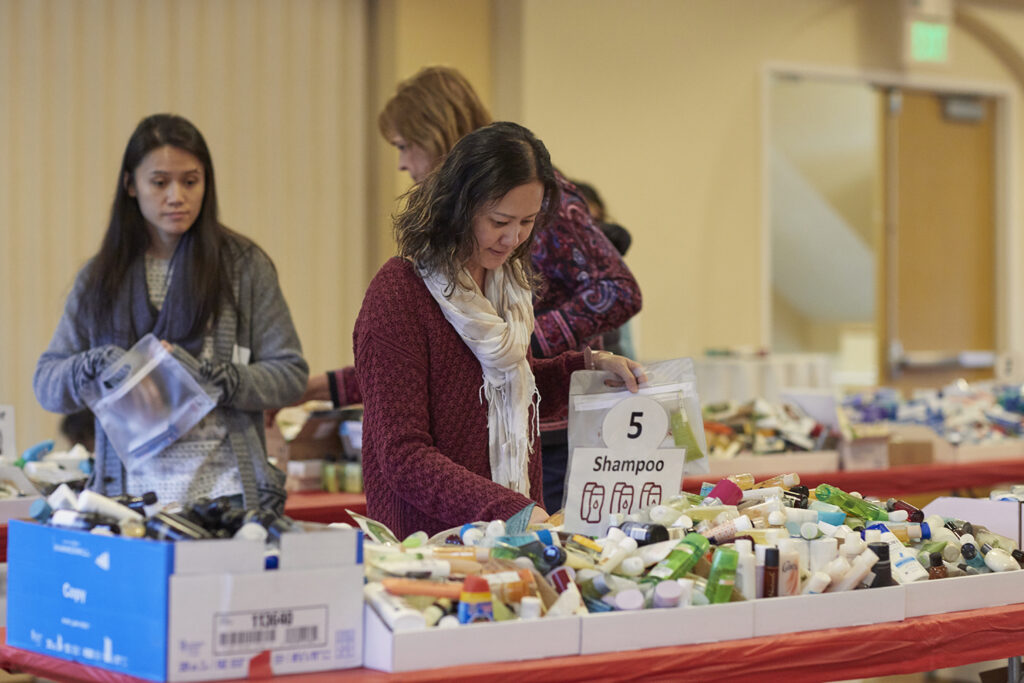The new Cardinal at Work Cares program launches Nov. 1 with more ways to give back
The expanded employee give-back program includes an online platform that makes it easy to find opportunities to volunteer, and Stanford’s month-long donation drive, which returns in person for the first time since the pandemic.

Employees assemble packages of personal care items for those in need during the November 2019 Cardinal at Work Cares donation drive. The donation drive returns this year with more ways to participate. (Image credit: Edgar Alexis Miranda-Medorio)
In January of 2022, Leilani-Jade Pecher-Reyes was looking for a way to bring her colleagues in the Office of the Vice Provost for Student Affairs together by giving back to the community when she saw a posting for a new volunteer opportunity on campus. BeWell Champions were invited to arrange a community service project through HandsOn Bay Area, an organization that partners with employers to provide goods and services to local nonprofits and schools in need.
Thrilled, Pecher-Reyes and a coworker signed up, and, last spring, her office held two gatherings in which team members assembled fleece blankets for people experiencing homelessness.
“Stanford does a lot of great things, but this was the first time I’ve been able to do a volunteer project with my colleagues,” says Pecher-Reyes, who is a BeWell Champion. “It’s a way to build connection on a deeper level. We’re all coming in for the same purpose: to give back and help.”
Pecher-Reyes and her colleagues were part of a pilot being tested by the Employee Support Programs and Services (ESPS) division of University Human Resources (UHR) and Stanford’s Office of Community Engagement, exploring ways to expand Stanford’s popular Cardinal at Work Cares annual donation drive. The pilot was a success – more than 500 employees participated in community service projects ranging from packing canned goods to assembling seed kits. This November, an expanded Cardinal at Work Cares program formally launches, with a new online platform that connects employees with more volunteer opportunities and the return of the in-person donation drive for the first time since the pandemic.
A call for community engagement
In 2020, in response to nationwide social unrest and the isolation people experienced at the outset of the COVID-19 pandemic, the Office of Community Engagement and UHR formed a 20-member task force to find ways to build community on campus. The resounding feedback from in-person sessions and survey responses was that Stanford employees wanted to engage more, both with each other and their surrounding communities.
“It’s a way to build connection on a deeper level. We’re all coming in for the same purpose: to give back and help.”
—Leilani-Jade Pecher-Reyes
“Any time you talk to Stanford employees, you hear the same thing,” says Stefani Bartman, who works in communications for UHR. “They like the feeling of connectedness; they want to do work that feels meaningful, and they have a lot of pride in being part of the Stanford community.”
Bartman and her colleagues knew this from their experience launching the original Cardinal at Work Cares program, first held in 2016. By 2019, the last year the popular donation drive was held before the pandemic, about 900 volunteers assembled 3,200 boxes of personal care items and collected 1,000 coats for City Team, the Ronald McDonald House at Stanford, and others in need, including survivors of wildfires in the area.
More ways to give
The donation drive returns in person this year as part of the newly expanded Cardinal at Work Cares program, along with the new Community Opportunities online platform for benefits-eligible faculty and staff members to view, share, and sign up for volunteer opportunities through Stanford or community partners. After logging in (you may be prompted to use Duo two-factor authentication), you can customize the opportunities you’ll see by selecting causes you’re passionate about, indicating your skills and interests, and following organizations to receive notifications when they post a new opportunity.
The program will also include twice-yearly opportunities to apply for team-based service projects like the blanket making Pecher-Reyes and her colleagues participated in.
Part of the goal of the new Cardinal at Work Cares program is to highlight and connect people to the many service and volunteer opportunities that already exist on campus.
The question the task force asked was, “There’s so much happening – how do we capture that and elevate that and make that available to everybody?” explains Jamie Silacci, senior manager of events and outreach for UHR, who helped design and implement the newly expanded program. “I’m super excited to see this launch and what the response is.”
Elizabeth Zacharias, vice president for UHR, agrees. “The task force’s vision was to deepen our culture of service to others. I greatly appreciate that input from so many across campus has culminated in an expanded Cardinal at Work Cares program that celebrates the value of service and creates meaningful, organized engagement between Stanford and the communities in which we work and live.”